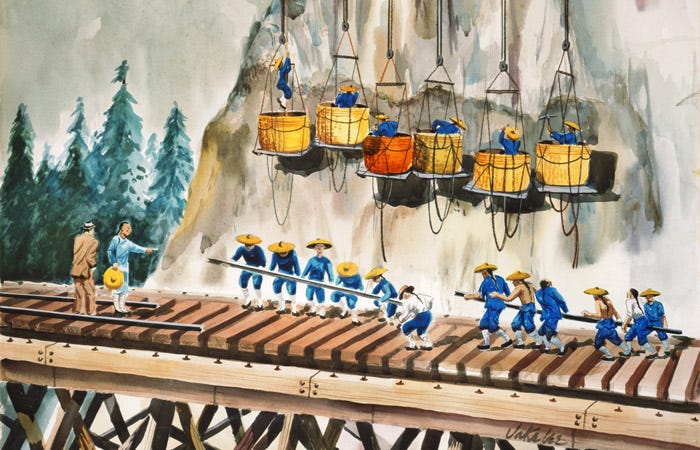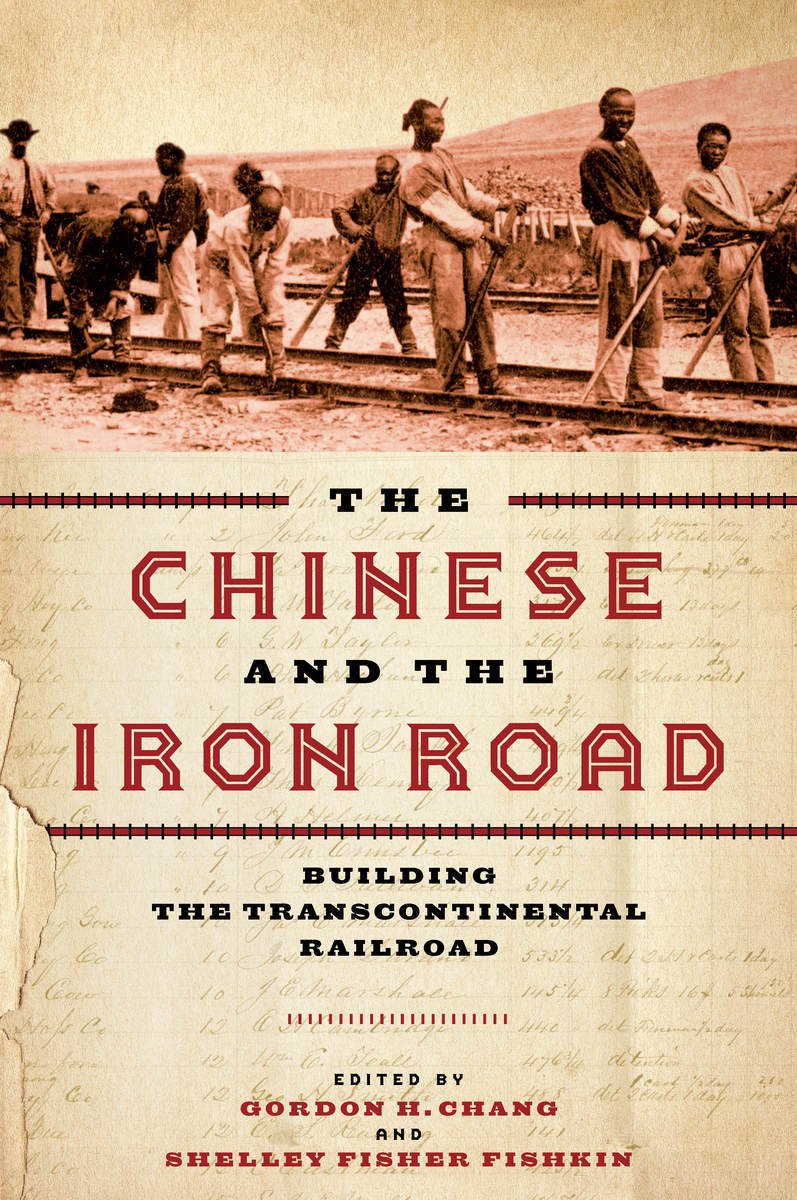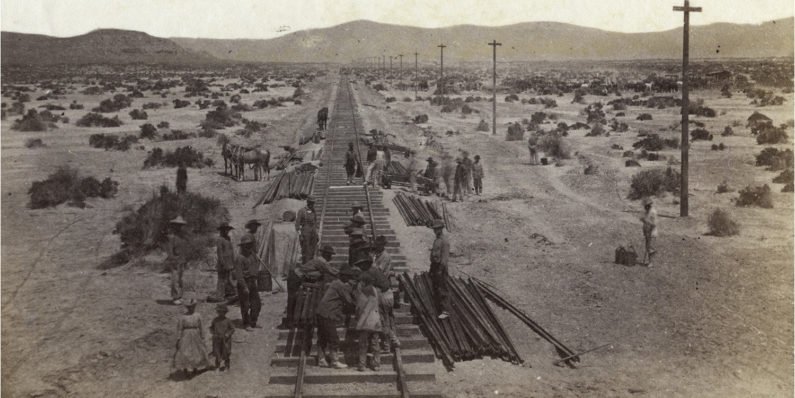12,000
Several thousand Chinese men had signed on by the end of that year; the number rose to a high of 12,000 in 1868, comprising at least 80% of the Central Pacific workforce.How many Chinese workers helped to build the railroad?
About 10,000 to 15,000 Chinese workers came to the United States to build the Central Pacific Railroad. Chinese workers found some economic opportunity but also experienced hostility, racism, violence, and legal exclusion. Many came as single men; others left families behind.
How many Chinese did the railroad company hire at the height of building the railroad?
To meet their manpower needs, both railroads employed immigrants to lay the track and blast the tunnels. The Central Pacific hired more than 13,000 Chinese laborers and Union Pacific employed 8,000 Irish, German, and Italian laborers.
Who made up the majority of workers for the Central Pacific Railroad?
Chinese
Leland Stanford, president of Central Pacific, former California governor and founder of Stanford University, told Congress in 1865, that the majority of the railroad labor force were Chinese.
Did the Chinese work on the Central Pacific Railroad?
The 660 miles of the Central Pacific railroad started in Sacramento in 1863. Between 1863-1869 the Central Pacific hired more than 13,000 Chinese laborers to support the construction.
What cultural groups contributed to building the railroad?





Which group of immigrants made the construction of the Transcontinental Railroad possible?
The Central Pacific Railroad, which was tasked with constructing the western half of the Transcontinental Railroad, began hiring Chinese workers in 1864 after facing a labor shortage that jeopardized the railroad's completion.
Frequently Asked Questions
Which ethnic groups were most responsible for constructing the Transcontinental Railroad quizlet?
Chinese, Irish, and German immigrants were hired to build the railroad because they worked for less money and many American men were: serving in the army, wanted higher paying jobs, left for the gold rush. Why did both railroad companies prefer to use immigrant labor?
Why do so many immigrants work in construction?
Still, construction jobs — those open to nonunion workers — are a rare source of opportunity for asylum seekers. “It's job security,” said Yadira Sanchez, a co-founder of Worker's Justice Project, who noted that roles commonly offered to migrant women, like house cleaning, offer more sporadic hours and often pay less.
Which of the following was not a reason that most members of immigrant families had to get a job?
Expert-Verified Answer. Their right to vote was dependent on their jobs was not a reason that most members of immigrant families had to get a job. The main reason immigrant came to America was to get jobs and better facilities.
What is forced labor called?
The Definition of forced labour
29) , forced or compulsory labour is: "all work or service which is exacted from any person under the threat of a penalty and for which the person has not offered himself or herself voluntarily."
What were the buildings poor immigrant factory workers lived in?
Tenement housing dates back to the 19th century but still exists in the 21st century, often in the form of low-income housing complexes. Tenements first arose during the industrial revolution, as newly landed immigrants seeking opportunities and looking for work needed affordable housing.
Who lived in tenements during the Industrial Revolution?
The immigrant poor lived in overcrowded, unsanitary, and unsafe housing. Many lived in tenements, dumbbell-shaped brick apartment buildings, four to six stories in height. In 1900, two-thirds of Manhattan's residents lived in tenements. In one New York tenement, up to 18 people lived in each apartment.
Where is forced labor?
Law enforcement in the United States has uncovered forced labor in a variety of industries. Other (Restaurant/Food Service, Hospitality, etc.) There are 24.9 million victims of forced labor worldwide. In the United States, domestic work is the most common venue for labor exploitation, including forced labor.
Who was responsible for the Transcontinental Railroad?
In 1862 Congress passed the Pacific Railroad Acts which designated the 32nd parallel as the initial transcontinental route and gave huge grants of lands for rights-of-way. The legislation authorized two railroad companies, the Union Pacific and the Central Pacific, to construct the lines.
Which group of people primarily built the Transcontinental Railroad?
Teachers should understand that most of the people who worked to build the transcontinental railroad were immigrants from China and Ireland. These immigrants faced discrimination in the U.S., but their labor made this national achievement possible.
What groups of people help build the railroad?
Many workers contributed to the construction of railroads. On the East Coast, Native Americans, recently freed black people, and white laborers worked on the railroads. On the West Coast, many of the railroad workers were Chinese immigrants.
Which groups of people helped build the railroad quizlet?
FAQ
- Who built the Transcontinental Railroad quizlet?
- The Central Pacific and the Union Pacific were the two companies charged to build the Transcontinental Railroad. Although the government funded and approved the building of the Transcontinental Railroad before the Civil War, the main construction of the railway began after the Civil War around 1865.
- What groups of people were involved in building the transcontinental railroad?
Beginning in 1863, the Union Pacific, employing more than 8,000 Irish, German, and Italian immigrants, built west from Omaha, Nebraska; the Central Pacific, whose workforce included over 10,000 Chinese laborers, built eastward from Sacramento, California.
- What group of immigrants were known for building the railroads?
The building of the Transcontinental Railroad relied on the labor of thousands of migrant workers, including Chinese, Irish, and Mormons workers. On the western portion, about 90% of the backbreaking work was done by Chinese migrants.
- Which group of immigrants helped construct the Central Pacific Railroad?
Chinese laborers
The 660 miles of the Central Pacific railroad started in Sacramento in 1863. Between 1863-1869 the Central Pacific hired more than 13,000 Chinese laborers to support the construction.
- What two ethnic groups helped to build the railroads?
Teachers should understand that most of the people who worked to build the transcontinental railroad were immigrants from China and Ireland. These immigrants faced discrimination in the U.S., but their labor made this national achievement possible.
- Why were Chinese workers hired to build the transcontinental railroad?
The Central Pacific Railroad, which was tasked with constructing the western half of the Transcontinental Railroad, began hiring Chinese workers in 1864 after facing a labor shortage that jeopardized the railroad's completion.
- Why did Chinese workers first come to America?
Chinese Immigration and the Chinese Exclusion Acts. In the 1850s, Chinese workers migrated to the United States, first to work in the gold mines, but also to take agricultural jobs, and factory work, especially in the garment industry.
- When did Chinese workers begin to build the Transcontinental Railroad?
Between 1865 and 1869, thousands of Chinese migrants toiled at a grueling pace and in perilous working conditions to help construct America's first Transcontinental Railroad.
- Where did the Chinese work on the Transcontinental Railroad?
The smoke and steam that filled the skies between Sacramento, California and Promontory Summit, Utah Territory owes much to the 10,000 Chinese laborers whose tireless efforts made the first transcontinental railroad a reality.
- What was the impact of the Chinese on the Transcontinental Railroad?
Between 1863-1869 the Central Pacific hired more than 13,000 Chinese laborers to support the construction. It took the construction crews, comprised of 80% to 90% Chinese laborers, fifteen months to drill and blast through 1,659 feet of rock to complete the Summit Tunnel at Donner Pass in the Sierra Nevada Mountains.
Why did transcontinental railroad builders initially prefer to hire chinese workers?
| What were the major challenges of building the transcontinental railroad? | Each company faced unprecedented construction problems—mountains, severe weather, and the hostility of Native Americans. On May 10, 1869, in a ceremony at Promontory, Utah, the last rails were laid and the last spike driven. |
| Which describes a major challenge facing the builders of the transcontinental railroad responses? | Answer. Crossing the Sierra Nevada Mountains would be your answer. |
| Which were the results of the construction of the transcontinental railroad? | Just as it opened the markets of the west coast and Asia to the east, it brought products of eastern industry to the growing populace beyond the Mississippi. The railroad ensured a production boom, as industry mined the vast resources of the middle and western continent for use in production. |
| Which difficulties did builders of the transcontinental railroad find ways to overcome? | The following are two of the difficulties that builders of the transcontinental railroad found ways to overcome: Natural barriers such as mountains, rivers. and forests. A need for workers. |
| What was the most difficult challenge of building the Transcontinental Railroad? | For the US government and the railroad companies, the biggest obstacles in building the Transcontinental Railroad were mountains of solid granite and attacks by Native American war parties. |
| Why was building the transcontinental railroad so difficult? | The job was not easy. Both railroads had to cross rugged terrain, desert and mountains and both had to deal with harsh weather. At times the greatest danger came from the Indian raids as the railroads intersected the Native Americans' land. The Indians attacked the crews in order to protect their homeland. |
| What problems did the transcontinental railroad solve? | In addition to transporting western food crops and raw materials to East Coast markets and manufactured goods from East Coast cities to the West Coast, the railroad also facilitated international trade. The first freight train to travel eastward from California carried a load of Japanese tea. |
| What was one consequence of the construction of the transcontinental railroad? | The Transcontinental Railroad reduced travel time from New York to California from as long as six months to as little as a week and the cost for the trip from $1,000 to $150. The reduced travel time and cost created new business and settlement opportunities and enabled quicker and cheaper shipping of goods. |
| What was the big obstacle to the transcontinental railroad How was that obstacle overcome? | Builders of the transcontinental railroad faced geographical obstacles across the entire line. But none were quite as formidable as the snowy granite mountain range rising east of Sacramento. Getting through the Sierra Nevada would require fortitude, technology -- and the sacrifice of many workers' lives. |
| What was the most difficult part of building the Transcontinental Railroad? | The Central Pacific met its greatest challenge at the outset—the towering Sierra Nevada, which presented enormous engineering obstacles and strangling winter snows. Deep fills, rock cuts, high trestles, snaking grades, and 15 tunnels through 6,213 feet of solid granite blooded the CP crews. |
- How much do American companies pay Chinese workers?
A recent survey of 48 U.S.-based companies operating in China, conducted by the U.S. Chamber of Commerce office in Beijing, found respondents offered an average hourly wage of $5.25 excluding benefits, or about $10,900 per year.
- What is the average hourly rate of a Chinese factory worker?
According to a salary survey in 2018, a factory worker's salary in China is USD 5.51 per hour. Compared with other economic superpowers like the US and Germany, China is one of the most inexpensive countries in terms of labor costs.
- How much do Chinese construction workers make?
The average pay for a Construction Worker is CNY 100,152 a year and CNY 48 an hour in Shanghai, China. The average salary range for a Construction Worker is between CNY 73,311 and CNY 119,381. On average, a High School Degree is the highest level of education for a Construction Worker.
- Are Chinese factory workers underpaid?
- The ILO found wage earners in China made an average equivalent of just $656 a month, ranking them 57th out of the 72 countries the report covered. The key word is 'world' average. The world average was $1,480 a month. That includes countries from India to rich Luxemburg, where average workers earned $4,089 a month.
- How much is labor in China compared to the US?
Finds that Chinese unit labour costs are about 25-40 per cent of US labour costs. They are also low relative to costs in the EU, Japan, Mexico, Korea and most other newly industrialising countries.
- How were the Chinese discriminated against during the construction of the Transcontinental Railroad?
- They were paid less than white workers, and hundreds lost their lives as a result of the dangerous work, said Gordon Chang, professor of American history at Stanford's School of Humanities and Sciences. A Chinese laborer works at a tunnel heading above Donner Lake on the western summit of the Transcontinental Railroad.
- What role did Chinese people play in the building of the railroads?
Between 1863-1869 the Central Pacific hired more than 13,000 Chinese laborers to support the construction. It took the construction crews, comprised of 80% to 90% Chinese laborers, fifteen months to drill and blast through 1,659 feet of rock to complete the Summit Tunnel at Donner Pass in the Sierra Nevada Mountains.
- How many Chinese died during the construction of the Transcontinental Railroad?
1,200 died
Between 1865-1869, 10,000 -12,000 Chinese were involved in the building of the western leg of the Central Pacific Railroad. The work was backbreaking and highly dangerous. Approximately 1,200 died while building the Transcontinental Railroad. Over a thousand Chinese had their bones shipped back to China to be buried.
- How did the Chinese respond to working conditions on the Transcontinental Railroad?
The men, many of them from Canton in southern China, had demands: They wanted pay equal to whites, shorter workdays, and better conditions for building the country's first transcontinental railroad. So they put them to their employer, the Central Pacific Railroad, and a strike was on.
- How were Chinese workers treated on the railroad?
- They were paid less than white workers, and hundreds lost their lives as a result of the dangerous work, said Gordon Chang, professor of American history at Stanford's School of Humanities and Sciences. A Chinese laborer works at a tunnel heading above Donner Lake on the western summit of the Transcontinental Railroad.

